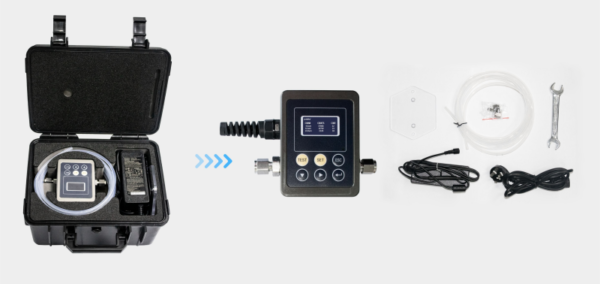1.What is the Oil particle sensor?
1.The introduction of the Oil particle sensor
Oil particle sensor is a sensor device used to detect the degree of contamination of particulate matter in oil, also known as oil cleanliness monitoring sensor. It is based on specific physical principles, such as optical or electromagnetic induction, to monitor and evaluate the quantity and size distribution of particles in oil in real time, providing a quantitative analysis of the degree of oil contamination.
2.What are the main impurities in oil particles?
Particles in oil usually include solid particles, metal particles, non-metallic abrasive particles, moisture, aging products and harmful gases. The source of these particles may include equipment wear and tear of metal abrasive debris, dust and impurities from the outside world, oil in the process of storage and use of sediments, and so on.
3.The impact of oil impurities on equipment
Influence on the normal operation of the equipment: particles in the oil, if more than a certain amount, will affect the lubrication, cooling and other functions of the oil, which will lead to increased wear and tear of the equipment, or even failure. Real-time monitoring through the oil particulate sensor can detect the problem in time and take measures to ensure the normal operation of the equipment.
Reduce the efficiency of oil use: oil particles sensor to help users understand the actual condition of the oil, so as to more reasonably arrange the use of oil and replacement cycle. This avoids waste caused by premature oil replacement and prevents equipment performance from being affected by delayed replacement.
Shorten equipment life: Contaminants in oil can cause corrosion and wear on equipment, shortening its life. Oil particle sensors can remove contaminants from oil in a timely manner through monitoring, thus reducing damage to equipment and extending equipment life.
Prone to accidents: In some critical industrial areas, such as aviation, shipping, petrochemicals, etc., the quality of oil is directly related to the safety of production. The oil particle sensor can effectively prevent production accidents caused by oil pollution and guarantee the continuity and safety of production.
Not conducive to environmental protection: Reasonable monitoring of the degree of oil pollution also helps environmental protection, because reducing the waste and leakage of oil can reduce the pollution of the environment.
Increase maintenance costs: through real-time monitoring and management of oil, unnecessary maintenance costs and potential maintenance costs can be reduced, thus saving money for the enterprise.
4.Principle of Oil Particle Sensor
The working principle of oil particle sensor is mainly based on the principle of laser scattering. When a laser light source illuminates particles in an oil sample, the laser beam intersects with the particles and the light is scattered and forms scattered light. The optical sensor built into the oil particle sensor is responsible for receiving and measuring the intensity and angle of this scattered light. The sensor converts the collected light signals into electrical signals and uses internal algorithms to process the data and calculate the particle size distribution. Specifically, by measuring the intensity and scattering angle of the scattered light, the size and distribution of particles in the oil can be deduced.
5. Role of oil liquid particle sensor
Monitoring the degree of oil contamination: the oil particle sensor can monitor the content and distribution of particles in the oil in real time, so as to determine the degree of oil contamination. This is essential to ensure the normal operation of the equipment and extend the life of the equipment.
Fault diagnosis and early warning: By analysing and comparing oil parameters, oil particle sensors can help diagnose equipment faults. For example, abnormal contaminant concentrations may indicate equipment malfunction or contamination problems that require repair or fluid replacement. In addition, oil particle sensors can set threshold ranges for parameters and provide alarms or warnings when ranges are exceeded, alerting operators to take timely action.
Data logging and analysis: Oil particulate sensors often have data logging and analysis capabilities that allow them to record historical oil data and evaluate performance over time. This helps to identify potential problems and perform predictive maintenance, improving equipment reliability and operational efficiency.
Optimising maintenance schedules: The fluid quality and performance data provided by lubricant particle sensors can help to develop more rational maintenance schedules. Based on the test results, it is possible to determine the need to change the oil, adjust the lubrication cycle or take other maintenance measures to extend equipment life and improve operational efficiency.
6. Types of Oil Particle Sensors
Through different measurement techniques, oil particle sensors can be divided into 3 categories.
(1) Optical sensors
Shade/optical resistance type sensor: able to quantitatively measure the size distribution of solid particle pollutants in the oil, fast and accurate detection. However, this type of sensor mainly relies on imports, the price is higher, and the detection may be affected by water and air bubbles in the oil.
Light scattering sensor: It can also quantitatively measure the size distribution of solid particles in the oil, and has high detection speed and accuracy.
Light Transmission Sensor: Qualitatively evaluates the solid particle contamination of the fluid by transmitting light intensity. However, its detection results are easily affected by the colour of the oil, bubbles and moisture (e.g. emulsified state).
(2) Electromagnetic sensors
This type of sensor uses the magnetic properties of metal particles in the contaminated oil to achieve the detection of contamination. For example, the magnetic plug sensor through the permanent magnet on the adsorption of metal particles and the probe’s detection role, to establish the number of contaminated particles and the detection results of the function between the relationship. This type of sensor has the advantages of simple structure, fast detection speed, but the disadvantage is that the detection accuracy is low, and can only detect pollution particles with magnetic properties.
(3) Other types of sensors
Also includes such as viscosity sensors, density sensors, etc., these are not direct measurement of particles, but can be indirectly reflected through the physical properties of oil oil pollution or aging.



